 At a glance
At a glanceExpert's Rating
Pros
- Excellent CPU and gaming performance
- Flashy RGB lighting is manageable
- Great cooling
- Good value, even for the price
- An easy-to-install AI art creator
Cons
- Rear-mounted power port can be finicky
- Heavy; may not fit inside some backpacks
- Battery life is, as expected, poor
- Clunky, slow utility software
- Loud fan noise while at maximum performance settings
Our Verdict
MSI’s Raider GE78 HX delivers outstanding gaming performance and a solid overall experience, with an occasional rough edge that doesn’t mar its shine.
Best Prices Today: MSI Raider GE78 HX 14VIG-600US
The MSI Raider GE78 HX 14VIG arrives as the era of Intel’s 14th-gen Core HX chips dawns, delivering more than we expected, frankly.
The Raider is unabashedly a gamer’s laptop, with cascading RGB keys and a light bar that runs the width of the laptop. Boot up a game and the fan kicks in, hissing loudly. But the Raider also ships with a surprisingly decent keyboard, a very nice screen, and enough conveniences to consider using it full-time. This 17-inch laptop certainly holds its own, and in many cases is the fastest gaming laptop we’ve seen to date. It has some quirks, though, one of which I found truly annoying. Read on to learn more.
Looking for more options? Check out PCWorld’s roundup of the best gaming laptops.
MSI Raider GE78 HX 14VIG: Basic features
Every version of the MSI Raider GE78 HX family is a 17-inch notebook. Other members of the GE78 HX family include the $2,699 MSI Raider GE78 HX VHG and the $2,399 MSI Raider GE78 HX VGG. The only difference between these models is the GPU: the HX VHG includes an RTX 4080 and the HX VGG includes a RTX 4070.
MSI also offers a Raider GE68 HX, a 16-inch notebook with a variety of display options including a 4K 120Hz display. The GE78 also provides a maximum of 250W to the CPU and GPU, while the GE68 provides up to a maximum of 240W.
Our review unit was sent to us by Intel and listed as an engineering sample. There are two differences we noticed between our review unit and what is on MSI’s website. Our review unit only has 32GB of RAM, and it runs Windows 11 Pro. We didn’t see any configuration options on any of the retailers, including MSI. MSI offered us a traditional retail review unit, which we initially declined after MSI provided us up-to-date software that approximated the retail version. It didn’t. Several apps didn’t work properly on the engineering sample, but did on the retail unit.
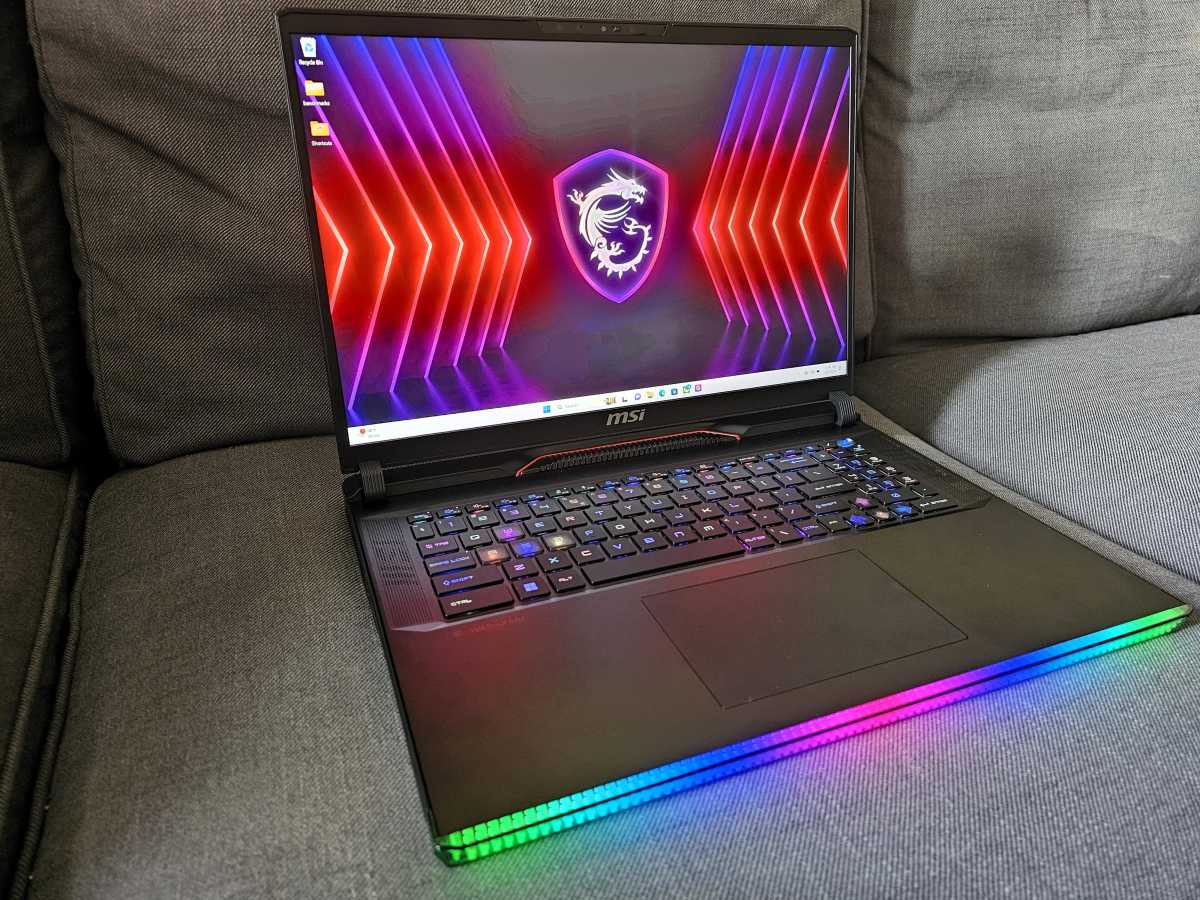
Mark Hachman / IDG
MSI Raider GE78 HX 14VIG: Specifications
- Display: 17-inch (2560×1600, 240Hz) IPS
- Processor: Core i9-14900HX
- Graphics: Iris Xe Graphics/Nvidia GeForce RTX 4090 (16GB GDDR6)
- Memory: 64GB DDR5-5600 (32GB as tested)
- Storage: 2TB NVMe Gen 4 SSD
- Ports: 3 USB-C (Thunderbolt 4, 10Gbps DisplayPort, 10Gbps DisplayPort+Power Delivery), 2 USB-A (1 10Gbps, 1 5Gbps), HDMI 2.1 (4K120), 1 SD Card 5.0 slot, 3.5mm jack, Kensington lock
- Camera: front-facing 1080p (Windows Hello) with shutter
- Battery: 95.0Wh (design)/94.4Wh (actual)
- Wired: Killer E3100G LAN (2.5Gbps)
- Wireless: WiFi 7 (Killer BE1750), Bluetooth 5.4
- Operating system: Windows 11 Home (Windows 11 Pro as tested)
- Dimensions (inches): 14.97x 11.73x 1.13in.
- Weight: 6.61 pounds
- Chassis: Plastic
- Colors: Black
- Price: $3,799.99
MSI Raider GE78 HX 14VIG: Design, build quality
A few years ago, the MSI Raider series weighed in at five pounds plus a bit more. Now, the GE68, with a 14th-gen chip inside, is 6.61 pounds total, which you will notice when hauling it out of the box. The 17-inch chassis also makes it a stretch, somewhat literally, to fit inside of a backpack, even one designed for gaming laptops.
Once powered up, though, MSI’s laptop immediately proclaims itself to be a gaming laptop. An LED light bar runs across the front edge of the 1-inch thick chassis, with individual, independent RGB lights running across the keys. The MSI logo on the rear of the display also cycles through various colors. You can, of course, turn these off, using the appropriate function key on the keyboard to do so.
Naturally, the Raider is well vented, with vents to either side and to the bottom of the chassis. MSI calls this technology Cooler Boost 5, with two fans and six heat pipes running internally. All of the hot air appears to be vented out the back and possibly on a narrow grill between the screen and keyboard. By default, the laptop ships in a state that combines a “MSI AI Engine” mode with an “MSI HybridGraphics” graphics setting to intelligently balance the needs of the CPU and GPU.
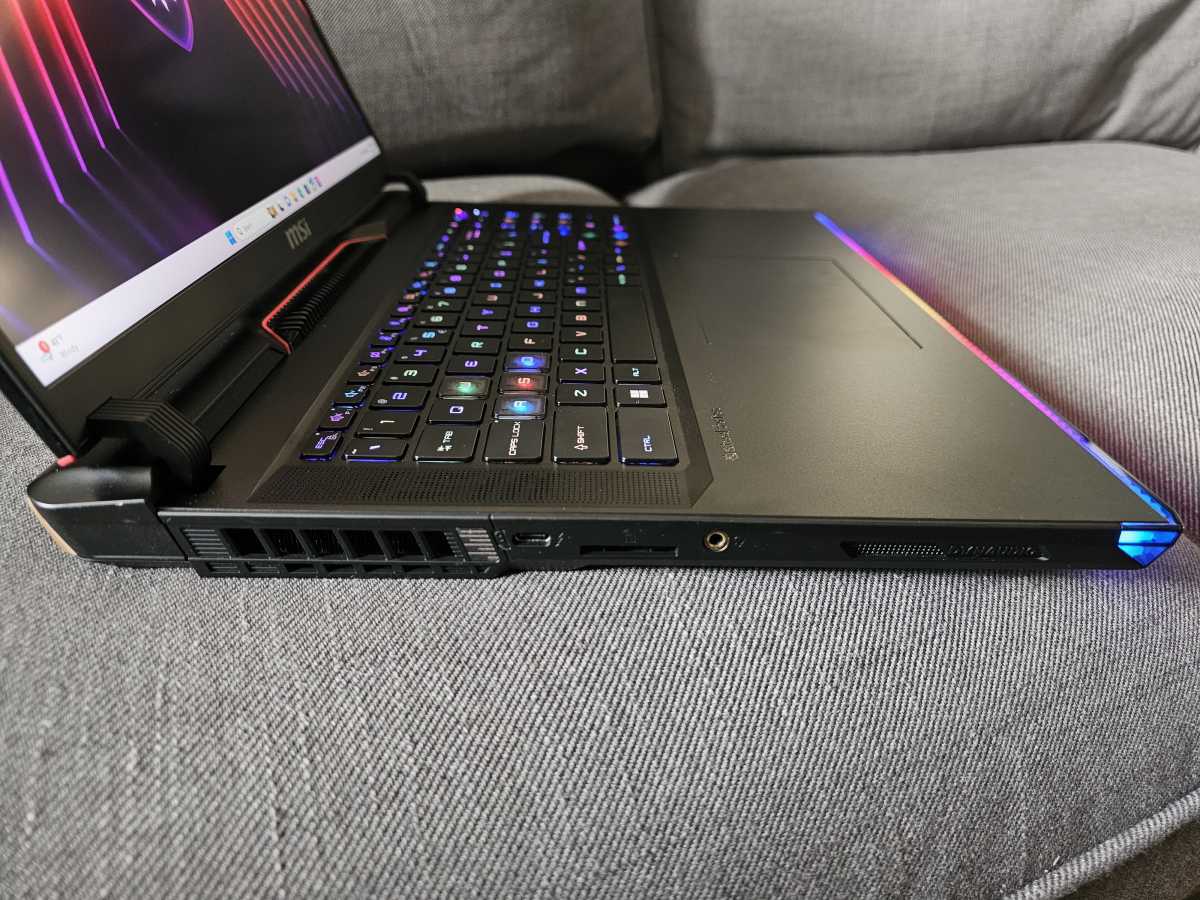
Mark Hachman / IDG
The fan didn’t kick in while browsing the Web, but in gaming it certainly does. The fans produce a very loud though neutral hiss, necessitating that you turn the volume up quite high or else use headphones.
The plastic construction is well put together, though there’s a bit of a wiggle to the display and a bit of keyboard flex if you press down firmly on the center keys. Two speakers are mounted on either side of the keyboard.
Perhaps the most annoying thing about the MSI Raider in my setup was the finicky power cable. While I admire MSI for building in a number of I/O ports, the Raider uses a rear-mounted rectangular power port that supplies the laptop with up to 330W of power. But the length of cord from the laptop to the power brick is short and heavy, enough that it often dislodged the power cable just enough to trigger pop-up safety warnings from MSI’s system utility. Sometimes the popups didn’t appear, and the laptop would slip quietly into battery mode.
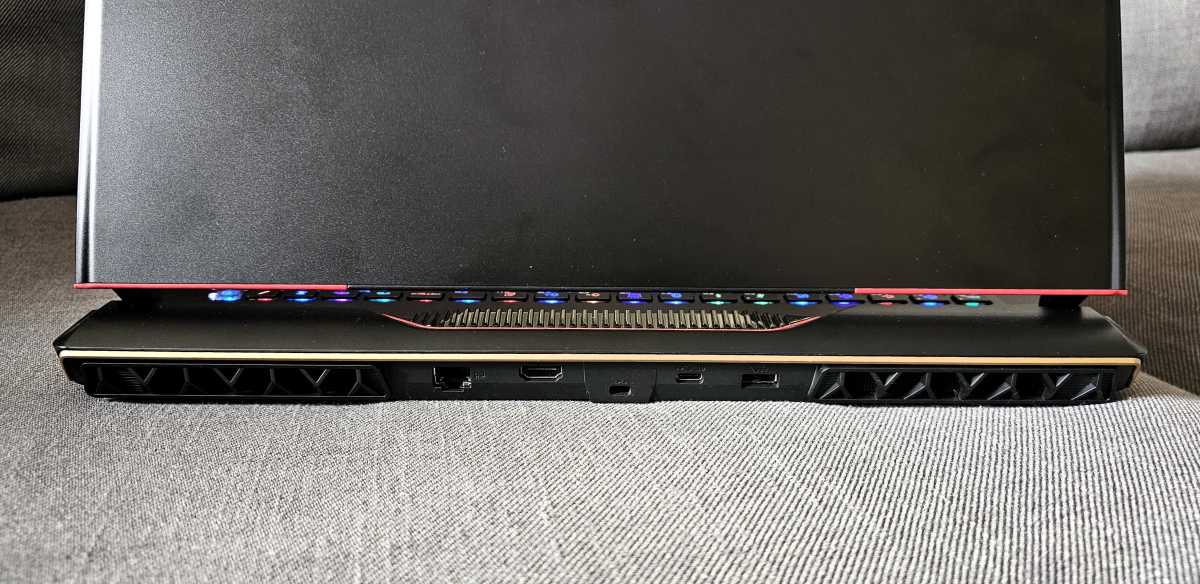
Mark Hachman / IDG
The constant warnings required me to remove and then reseat the power cable, or else the laptop would run on battery — no good for gaming! The only foolproof answer I found to that problem was to put the power brick on the same level as the laptop.
Yes, you might simply leave the laptop in place as essentially a desktop replacement. I was constantly moving it, checking small details and running benchmarks on a side table while I worked on the review. I can’t tell you how annoying it was to constantly have to reseat the power cable on the rear of the laptop.
I’ve never felt a such a strong affinity for side-mounted barrel chargers.
MSI Raider GE78 HX 14VIG: Display and ports
Otherwise, though, you’ll find that the MSI Raider GE78 HX 14VIG has more than enough room for multiple ports.
Those ports include three USB-C ports, noted above, which are marked to distinguish them from one another but with black-on-black labels that might require a flashlight to figure out which is which. Ditto for the two USB-A ports, which also differ in their capabilities. The SD card slot should prove useful for digital artists who capture images on an SD card. The only thing that the 2.5Gbps Ethernet port does, though, is make me anxious that I’m not taking advantage of the most powerful broadband offerings my ISP provides.
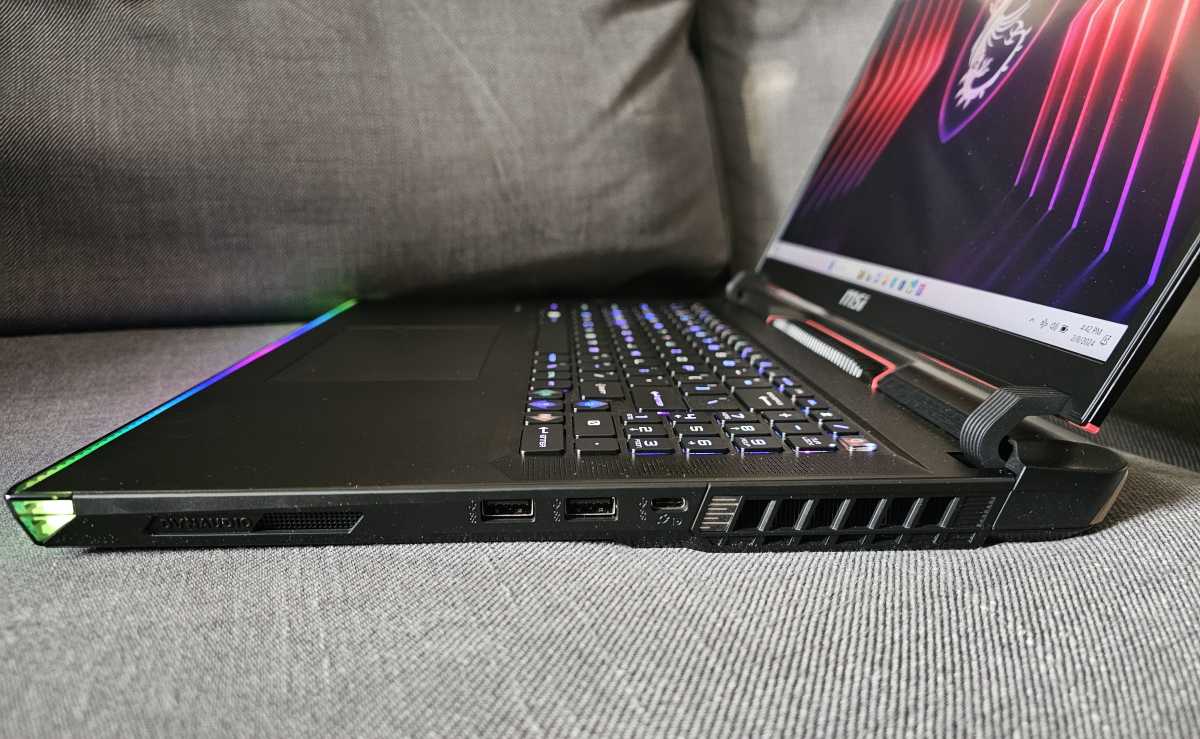
Mark Hachman / IDG
Note that this is a standard IPS display, rather than the OLED or miniLED displays rivals offer. Both of these other technologies provide better contrast, either by lighting pixels on a per-pixel basis (OLED) or by providing miniLED backlights, which divides up small portions of the screen into “zones” which can be entirely turned off to emulate the same effect. The Raider uses a standard LED backlight across the entire display. But it also avoids the “halo” effects that accompany miniLEDs, too.
We used our light meter to confirm that the Raider’s screen put out 463 nits of luminance in SDR mode. The laptop’s display is rated at HDR1000. Its contrast is 1,160:1, measured by our colorimeter.
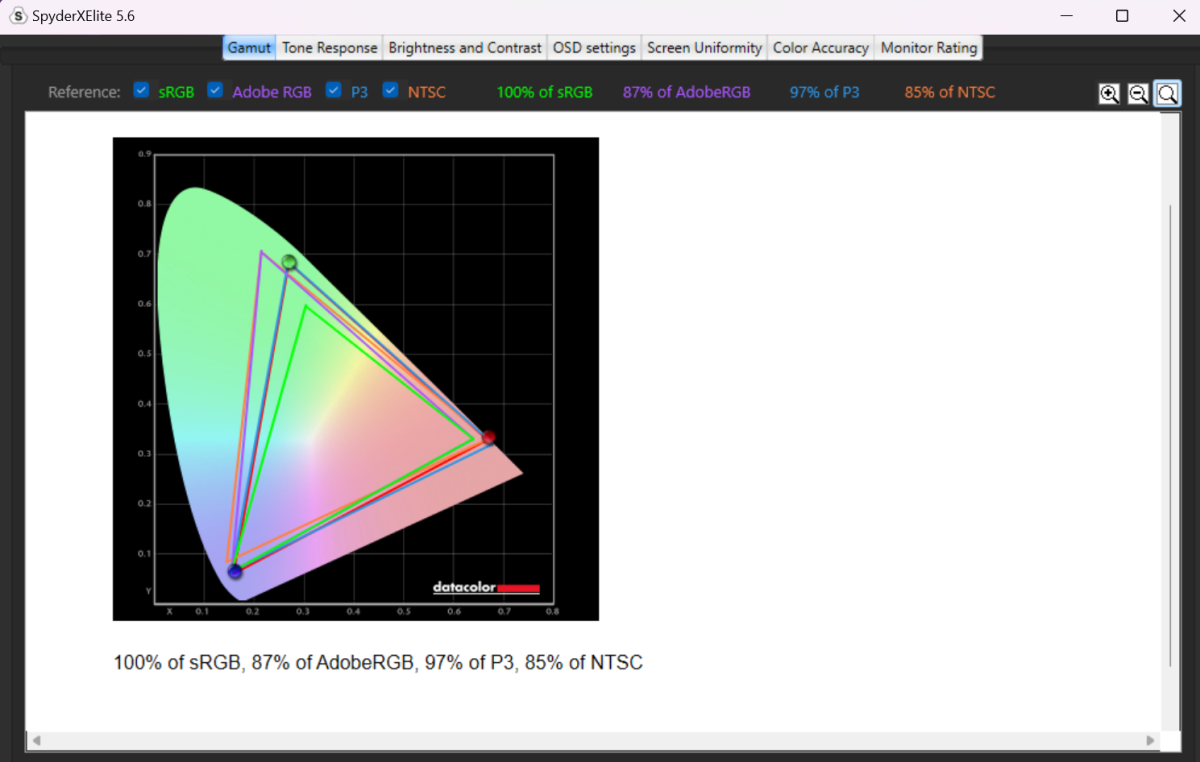
Mark Hachman / IDG
The Raider’s HDMI 2.1 port connected nicely to an external 4K120 display, providing an alternative to the native 1080p, 240Hz display inside the Raider. I love high-refresh-rate displays, but I appreciate the flexibility of connecting to a more ergonomic external screen.
It’s noteworthy, though, that the Raider has an option via its MSI settings menu to put the laptop into a mode where it uses the discrete graphics only, which triggers a switch on the motherboard to route the GPU directly to the display. This turns off the Thunderbolt ports. You’ll still have the option of running three displays (the internal screen, an external display via HDMI, and a third via one of the other USB-C ports) but it will take a bit of fiddling.
Inside the laptop is one of the first instantiations of Wi-Fi 7, along with Bluetooth 5.4.
MSI Raider GE78 HX 14VIG: Keyboard and LED
The Raider GE78 HX 14VIG includes a SteelSeries 99-key keyboard with per-key RGB lighting. Though MSI doesn’t use the mechanical keyboard on this model (you’ll have to buy an MSI Titan for that) I was surprised at how much I liked the feel of the keys. At 1.7mm, they don’t have quite as much travel as I’d prefer, but my fingers still bottomed out comfortably.
My biggest issue is only that the laptop is thick, with a 4.5-inch “chin” underneath the keys. That’s fine for resting your palms, but the keys are set back a bit further than I’d like. It also forces you to get used to the slightly raised keyboard deck.

Mark Hachman / IDG
As a lefty, though, I’m sensitive to the number pad, which I use for gaming. MSI includes one, but it’s squished in, with smaller-than-expected keys. MSI does highlight its translucent, backlit WASD keys (yay, righties!) with their own distinct lighting. But the keyboard is bracketed by the two speakers to the left and right. I’d like to see what would happen if MSI extended the keyboard to the full width of the chassis, and moved the speakers closer to the user.
The keyboard backlight allows you to turn off the RGB backlighting entirely, and an additional tap can turn off the lightbar on the front edge, as well as the logo backlight. The retail unit allowed me to control both the light bar and the per-key lighting in a number of patterns and colors. I wasn’t able to control the lighting via the Windows 11 Dynamic Lighting feature, however, which is what Microsoft has promised.
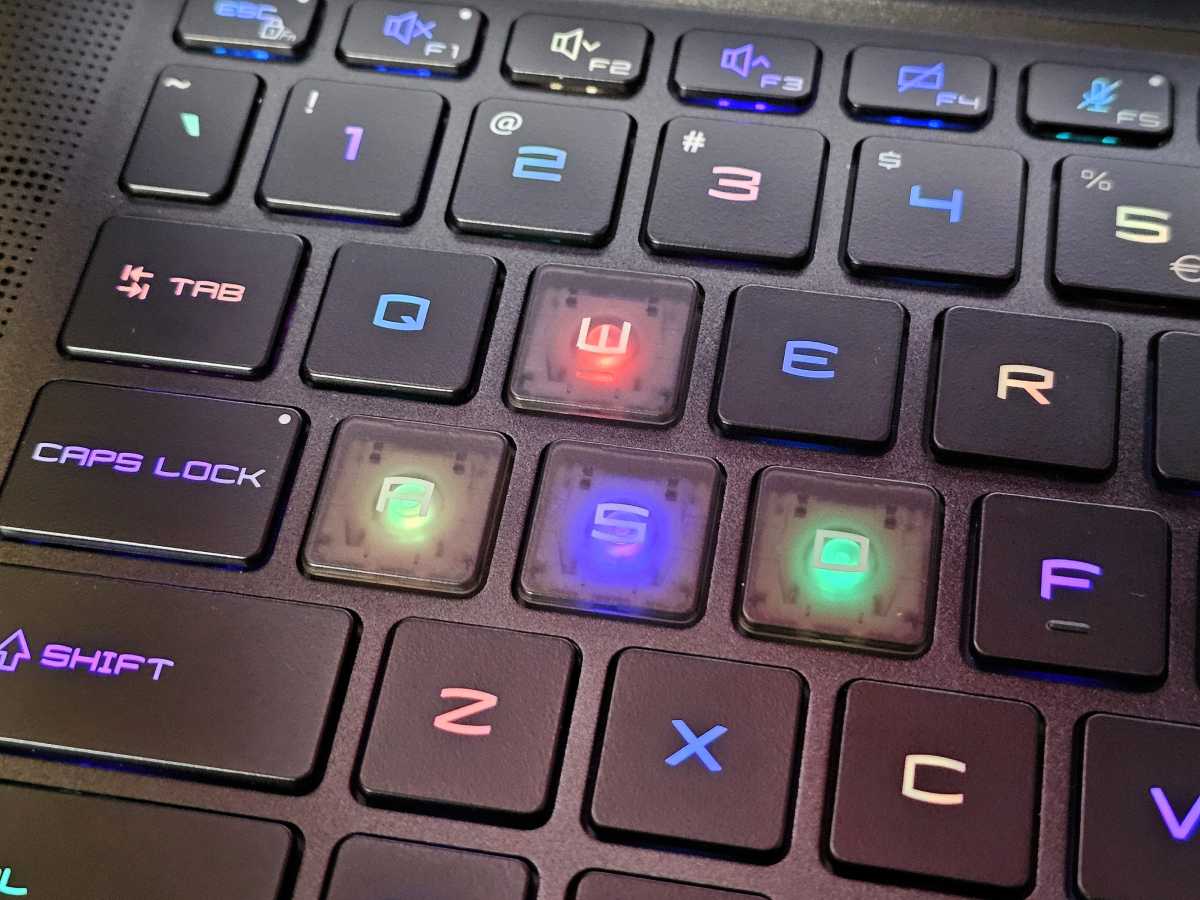
Mark Hachman / IDG
Note that the “Mystic Light” lightbar is similar if not identical to the 2023 edition, with discrete LED lamps hidden away behind a plastic shield that can be configured to use varying patterns. If you’re of a certain age, the words “Lite Brite” should help illustrate what MSI is going for. If they don’t mean anything to you, go back to playing Fortnite.
The overall RGB effect is a little over the top, a bit like an arcade or pachinko parlor. But the controls make it manageable for as long as you want to enable it.
Note that while there’s several levels of backlighting, there is no default “everything off” setting for long-term gaming while on battery. Something always remained on: the keyboard backlighting, or the light bar, or the “dragon&r
Войдите, чтобы добавить комментарий
Другие сообщения в этой группе

If you’ve been exhausted by the unstoppable deployment of AI chatbots

If you’re concerned that your favorite may be subsumed by the growing

I have yet to see an OLED gaming monitor go below the $400 mark, and

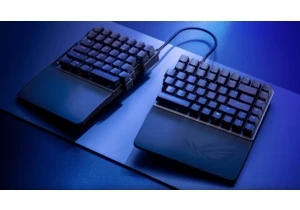
Split keyboards are hard to find, especially if you’re looking for so
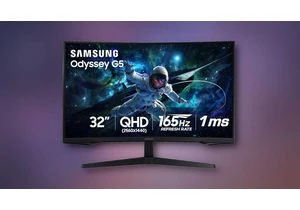
If you want to upgrade your budget PC gaming setup without shelling o

